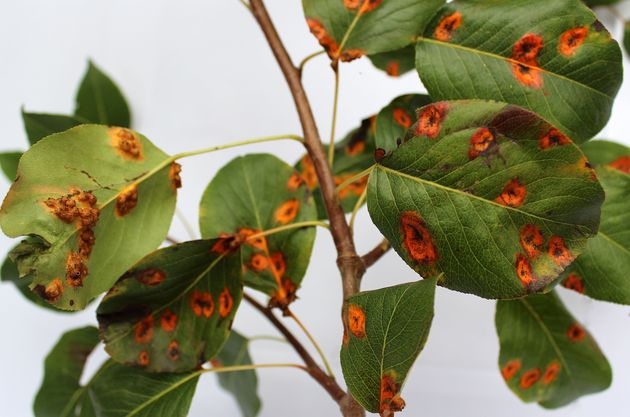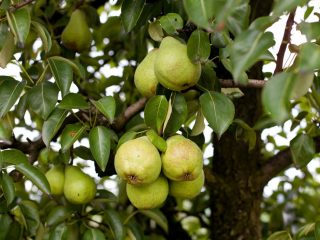Content
Anjou pear is one of the low-growing varieties of universal use. The fruits of the variety are used as an additive to dessert cheeses and salads; they are also used to make jam, compotes and are consumed fresh. On the territory of Russia, Anjou pear is zoned for cultivation in the North Caucasus region.
Description of the Anjou pear variety
There are 2 varieties of the variety - green and red Anjou pear. In the first subspecies, the skin of the fruit has a pale green color, which remains unchanged as it ripens. pears, except for a barely noticeable yellowness on part of the crop.
The ripeness of this variety is difficult to determine with the naked eye, however, there is a little trick that allows you to determine whether the pear is ripe. To do this, you need to gently squeeze the narrow part of the fruit, right at the stalk, with two fingers. If the pear yields to pressure, it means it is ripe.
The red Anjou pear variety was developed by accident. It is practically no different from its predecessor, with the exception of the yellowish-red hue of the fruit.
The height of an adult tree reaches 3.5 m, but there are also specimens of about 4 m. Harvesting is easy, especially from young trees.
In addition to its main purpose, the Anjou pear is used as a decorative element for the garden. The flowering of this species is abundant and very beautiful - small flowers with petals of delicate cream tones cover the tree with a dense layer already in April.
It is recommended to plant other varieties next to Anjou pears that will pollinate them:
- Sekel;
- Bartlett;
- Starking;
- Bere Bosk.
Fruit characteristics
Anjou pear is a large-fruited variety, despite the fact that it is a short tree. The average fruit weight is 250-300 g. Pears grow up to 8-9 cm in length, while their diameter can reach 8.5 cm.
The shape of the fruit is ovoid. The lower part is quite wide, but starting from the middle of the pear, the fruit begins to narrow. The upper part is narrow, but rounded at the end.
The skin color is light green. As the pear ripens, its fruits may turn slightly yellow, but in general their color does not change, which cannot be said about the red Anjou variety. It is similar to the green variety in all respects, however, the ripe fruits of this pear acquire a yellow-red color.
The taste of Anjou pear is sweet, harmonious, not too sweet, but not too sour. The pulp is dense.
Pros and cons of Anjou pear
The advantages of the Anzhu variety include the following characteristics:
- long shelf life of the crop - from 5 to 7 months;
- pleasant taste of fruits;
- decorativeness of wood;
- low calorie content of fruits, due to which they can be included in dietary dishes;
- versatility of use - you can grow it both for yourself and for sale;
- small size of the tree, which simplifies harvesting;
- large fruit;
- rich aroma with notes of lime.
As a disadvantage of the Anjou pear, gardeners highlight the need to plant other pollinating varieties next to it.
Optimal growing conditions
When choosing a site for planting Anjou pear, you should take into account the fact that this is a heat-loving variety that needs a lot of light. It is better not to thicken the plantings, although the trees develop well in conditions of moderate shade.
The requirements for soil composition are modest - the tree can be planted in almost all types of soil. Fertile, well-drained soil is best suited for this. Planting in heavy clay areas is not recommended, however, loamy soils are quite acceptable. If necessary, you can adjust the soil by adding
Planting and caring for Anjou pear
The agricultural technology for planting Anjou pears is simple and does not cause any difficulties. Caring for the variety is also easy due to its low growth. Resistance to low temperatures eliminates the need to cover the tree in regions with mild winters.
Landing rules
The Anjou pear planting algorithm looks like this:
- On the day of planting, planting material is soaked in a container with warm water. You can add a little growth stimulant to it for better survival of the seedling. The seedling is kept in water for 4-5 hours, no more.
- In the selected area, dig a hole about 70-90 cm deep. The dug soil is carefully placed next to the hole.
- The bottom of the planting hole is filled with fertile soil mixture. It is made independently. Composition of the mixture: topsoil from the garden plot, compost and peat moss, taken in a 2:2:1 ratio.
- The roots of the seedling are laid on top of the soil mixture, evenly distributing them along the bottom of the planting hole.
- The root system of the plant is sprinkled with soil and the trunk circle is lightly compacted.
- To better retain moisture after watering, it is necessary to dike the planting hole.
Sometimes after watering the soil sags a little. If this happens, the tree trunk circle is sprinkled with a small amount of earth, leveling it to the soil level.
Pollinator varieties are planted at a distance of 4-4.5 m from the plantings. This is the most optimal period for the transfer of pollen by wind and insects. If you plant trees closer, there is a risk that mature pear trees will interfere with each other. If you place them further away, pollination problems may arise.
Watering and fertilizing
The Anjou pear does not tolerate stagnant moisture in the soil, so water the tree infrequently - 1 watering every 2 weeks is enough. The frequency is increased only in case of prolonged drought or abnormal heat.
It is especially important to ensure that in November the tree trunk circle is not flooded with water, otherwise excess moisture in the soil in winter will injure the tree.
In order to get a bountiful harvest of pears, it is recommended to fertilize the plantings regularly. In the spring, for a better set of green mass, the pear is fed with nitrogen, which is contained in large quantities in organic fertilizers. During the period of active fruiting, they switch to fertilizing with potassium and phosphorus. Adding water-soluble fertilizers to the soil improves the pear's immune system.
The frequency of fertilizing depends on the age of the tree.Young pears do not need feeding, especially when grown on fertile soils and adding nutritious soil mixture to the planting hole. True, if the growth of a tree suddenly slows down, you can feed it.
This is done after the buds open, but at the same time it is important to do it before the end of July.
A deficiency of nutrients is indicated by the appearance of brownish or yellow spots on the leaves of the tree. Over time, the leaf blade of the pear begins to curl.
Trimming
Mature plants need to be pruned from time to time to form a crown. This is done in the spring, removing weakened or damaged shoots. Branches that are too long or simply in the way are also cut out. In addition, it is recommended to remove shoots that grow vertically and towards the center of the tree. This pruning is aimed at preventing thickening of the crown. For normal development of the pear, light must freely reach the internal branches, since excessive shading can create high humidity, which is an ideal environment for the development of a number of diseases.
It is not necessary to prune the Anjou pear in summer and autumn.
Whitewash
Anjou pears need to be bleached in spring and autumn. This procedure allows you to protect the tree not only from low temperatures in winter, but also from sunburn in the spring months. In addition, whitewashing repels pests and prevents the spread of certain diseases.
A combination of lime, glue and copper sulfate is used as whitewash. Algorithm for preparing the solution:
- 1 kg of lime is diluted in 7-8 liters of water.
- 200 g of copper sulfate is mixed with 100 g of PVA glue.
- Everything is poured into lime mortar and stirred thoroughly.
- When it becomes viscous enough, you can bleach the pear.
Instead of PVA glue, you can use clay. 200 g is enough. To do this, it is soaked in water until it softens to a thick paste, after which the clay can be added to the solution.
Another option for the mixture is crushed chalk and lime diluted in water-based paint.
Whitewashing of pears is carried out in the direction from bottom to top. So, excess whitewash, flowing down, will fill the missing hollows and gaps.
Preparing for winter
The Anjou pear variety is quite resistant to low temperatures, so adult plants are not covered for the winter. It is recommended to sprinkle young trees with a thick layer of mulch, up to 30-35 cm in height. Peat is usually used as a mulching material. Such protection will protect the pear root system from severe frosts.
If necessary, peat can be replaced with sawdust, covering the soil near the tree trunk with a layer of about 20 cm.
Before mulching the plantings, you can, as an additional precaution, cover the tree trunks with whitewash. You can make the solution yourself or purchase a ready-made mixture at any gardening store.
In regions with harsh winters, for better protection, seedlings are covered with insulating material, on top of which spruce branches are laid. Finally, snow is also used to protect the pear tree by raking it closer to the trunk and covering the tree down to the skeletal branches.
Productivity
The yield of the Anzhu variety is average.The harvest is harvested at the end of September, however, the fruits finally ripen indoors, at room temperature. Ripening time is 3-5 days.
Diseases and pests
In general, the Anjou variety is quite resistant to most diseases that affect pears. On the other hand, it is better to carry out a couple of preventive measures than to then treat the trees for some kind of infection that can wipe out all the plantings.
The main threats to the Anjou variety are:
- scab;
- rust;
- leaf roller.
The drug “Skor” or a solution of Bordeaux mixture will help to cope with rust. Spraying with urea, which also acts as a top dressing, and the chemical preparations “Ardent” and “Merpan” help against scab.
As additional preventive measures, it is recommended to burn fallen leaves and not plant trees near juniper - it is a carrier of rust.
Chemicals cannot be used against the leaf roller, since it attacks trees when fruits have already formed on them. It is better to spray the plantings with biologically based preparations, for example, Fitoverm.
You can learn more about how to deal with pear pests from the video below.
Conclusion
Anjou pear is perfect for growing in Russia. The variety safely tolerates fairly low temperatures in winter, bears fruit well even in unfavorable years and is highly versatile. The fruits can be grown not only for yourself, but also for sale.


















